The Cornell Lab Bird Academy › Discussion Groups › Nature Journaling and Field Sketching › Jump Right in!
-
Lesson One's photo drwg: I wasn't satisfied with this, the eye and beak are wrong, etc. So what I realized was I was already too critical with the process, and must try to be patient. The basic layout came quickly, the composition was already figured out by the photographer. I found the sketchbook page too small so I think I'll get the larger book recommended. I want to develop a quicker, tidier journal handwriting style. I noticed the positioning of the bird better, where it was on the branch, where the leaves were by drawing it. Practicing this should make things go faster for moving targets.

-
 Getting started with drawing from a picture is a great way to get started. Understanding how to draw the different textures was very difficult. Nature journaling will allow me to observer greater detail that I have not noticed previously.
Getting started with drawing from a picture is a great way to get started. Understanding how to draw the different textures was very difficult. Nature journaling will allow me to observer greater detail that I have not noticed previously. -
1. Yellow warblers don't pose, so it was good to have one hold still in the photo. It was all pretty challenging. I decided to try the pens that I got for the course. I think pen is less forgiving than pencil because you can't erase or shade. I tried to draw the whole scene and getting the texture of the bark was quite difficult/impossible. Plus, my bird looks 'flat,' not round. 2. I would not have noticed the shading around the head and back of the bird without drawing. Nor would I have noticed the 'stripey' look to the wings. So a nature journal would make you stop and look more closely.

-
 The beak was challenging for me. I think I really notice the proportions when I have to draw something. I think that is the advantage of drawing for a nature journal, you are forced to look at all of the details
The beak was challenging for me. I think I really notice the proportions when I have to draw something. I think that is the advantage of drawing for a nature journal, you are forced to look at all of the details -

-

-
Since this is my first serious try at drawing anything I think I did ok. I found drawing from a photo not as difficult as I thought and that I paid more attention to the detail of the bird than if I was taking a photo.

-
Yes, I think you did just fine!
-
-
I find drawing from a photo reference gets me in a very meditative state. However, when it comes to drawing from life, it gets you in this fast mode action & fun you get to use all your senses it really develops the muscle memory & makes you faster. I never tried drawing a moving bird I find it quiet difficult cause they are very active, birds would fly in a second, which makes it hard to capture. On the other hand I'm familiar with figure drawing, you get the chance to capture a human movement, cause humans tend to take their time waiting for their coffee or texting on their phones it would be easier to capture the gesture than a flying bird or other creatures. When it comes to color it is more accurate from life for sure, than a photograph, but the lights & shadows will keep on changing, which I think why photos would be easier if you want to make an accurate painting with shadows & lights. Drawing from life would be great for developing your gesture drawing skills, building your observation muscles & remembrance maybe. I think painting or drawing for nature journaling would be easier on still objects but the challenge would be the accuracy of the lights & shadows & the feeling, which will change depending on the time of the day, weather, how fast the object moves & how long you take on the painting. when it comes to anatomy you can always go back & study from a reference photo and redraw what you've already drawn on your nature journal.

-
I love this little painted card.
-
-
I thought using a photo was much easier to see the detail and capture something because the subject is frozen. It was a challenge because I do not know bird anatomy very well, had to sketch what I saw without knowing the parts. The photo has so much detail that it seems nearly impossible to capture the likeness of a bird without suffering lots of ugly's in real life. I may spend some time practicing sketching other pictures I have taken of birds to get more familiar with the parts. Hard to describe where the color is without the vocabulary. Seems like using photos and sketching in the field will benefit creating the Nature Journal. Pat

-
 I was able to take my time so I guess it felt easier than nature journalism. The texture was less challenging than what I thought but the form was challenging. I would´t have noticed the different levels of the wings or the subtle orange stripes in the body. Yes, I think it must be quite different To catch details and poses in live movement,
I was able to take my time so I guess it felt easier than nature journalism. The texture was less challenging than what I thought but the form was challenging. I would´t have noticed the different levels of the wings or the subtle orange stripes in the body. Yes, I think it must be quite different To catch details and poses in live movement, -
 It is much easier to draw from a photo. It gives me time to notice lots of details and work to make my drawing more accurate. The more details I add to my drawing, the more I learn about the subject and the better I remember the experience.
It is much easier to draw from a photo. It gives me time to notice lots of details and work to make my drawing more accurate. The more details I add to my drawing, the more I learn about the subject and the better I remember the experience. -

 While drawing I realized that I do not know bird anatomy very well so I was drawing what I saw without understanding what it was or how it works, this can be a + or - to the overall picture. Drawing from a photo is easy tho I am very rusty. I did use my eraser a few times. I liked the talons wrapping around the branch and want to draw these again in close-up. Pixel, my rat terrier, is glad that I'm done drawing so my lap is available.
While drawing I realized that I do not know bird anatomy very well so I was drawing what I saw without understanding what it was or how it works, this can be a + or - to the overall picture. Drawing from a photo is easy tho I am very rusty. I did use my eraser a few times. I liked the talons wrapping around the branch and want to draw these again in close-up. Pixel, my rat terrier, is glad that I'm done drawing so my lap is available. -
I find that drawing from photos gives you time to correct proportions and enables you to see more details. I have found that coloring is not always correct with photos compared to life. When the natural light hits whatever it is that you are drawing it gives different and more subtle changes than you get in many photos. I think in life you can draw more 3d looking pictures with capturing more natural movements. It is definately more challenging to draw from life in the elements and with light ever changing than it is to sit in front of a photo and draw and correct and take your time.

-
I prefer drawing from a photo, it gives me time to study the subject. For me the most challenging part of drawing is getting the sizing right and keeping it similar on the page. When sketching in the field I tend to pick objects that don't move to much or can't fly away, like a grass, flower, tree or a scene. I am hoping this class will help me to overcome the reluctance I have to sketch living things in the field.

-
Drawing from an image was fine. Drawing while they are flying is very difficult. What came easily was obtaining the shape and size of the warbler. It was adding the details that was more tricky because I tend to go overboard. I should have drawn the complete branch and leaves. Perhaps I would add details at home instead of in the field.
-

-
 Here is my Warbler drawing. Sorry that it's not very clear, my computer camera isn't very good.
Here is my Warbler drawing. Sorry that it's not very clear, my computer camera isn't very good. -
 Drawing from a photograph is fine - it allows me to take my time drawing, however, it feels like “flat”; a 2D image is being copied. It is good if i cant stay outside for long due to the weather conditions. The joy of observing is not there though.
I noticed the texture of the Podotheca as well as the form of the beak. Noticing the details is very important in nature journaling; it us part of sensing the bird being watched. It is of importance to point that observing bird’s behaviours for a while is enriching our visual memory. So that when we sketch it from a photograph -even if the photo is a bit blurred due to its fast movement- we will still be able to draw it accurately.
After uploading the image, i noticed that I forgot to add the name & information of the bird ^_^;
Drawing from a photograph is fine - it allows me to take my time drawing, however, it feels like “flat”; a 2D image is being copied. It is good if i cant stay outside for long due to the weather conditions. The joy of observing is not there though.
I noticed the texture of the Podotheca as well as the form of the beak. Noticing the details is very important in nature journaling; it us part of sensing the bird being watched. It is of importance to point that observing bird’s behaviours for a while is enriching our visual memory. So that when we sketch it from a photograph -even if the photo is a bit blurred due to its fast movement- we will still be able to draw it accurately.
After uploading the image, i noticed that I forgot to add the name & information of the bird ^_^; -
-
Drawing the Yellow Warbler helped me generalize what I Thought a yellow warbler looked like. I paid more attention to the shape of the body and to the details of the red stripes. Also, I saw how the values such as dark and darker helped define the wings, the beak and the eye. I'm aware how much easier it is to paint something that doesn't keep flitting around! I'm not sure a yellow warbler would hold still for me if I saw it in a bush!
-
I like drawing from the photo. I'm slow, and given that the image is a photo, the image moves much slower than I ... Getting the proportions right is a challenge for me. I really made attention to how the skeletal and the muscular structure is present in the photo. For example, I tried to imagine how the beak was not an appendage, but was an extension of the bird's skull. As well, I wanted to capture how the upper part of the covert of the wing had some contour. This exercise sharpened by observation skills. - I'm excited to see how I hopefully improve over the course.

-
I've always loved just sitting and observing nature. I've done a bit of journalling on some journeys I've taken in my VW camper. I'm not feeling very confident about it, but still when I look at the sketches or watercolors it brings back such wonderful feelings. I want to learn more about how to do this and have it become so natural that I don't hesitate to do it often. I love writing down what I see, but I don't necessarily do it in a very organized way. A nature journal at this time seems perfect for me. I loved seeding the examples of what other people did. I'd like to practice quick sketches of birds that show impression, behavior, posture, etc. I'm hoping by drawing birds and adding details it will help me recognize them when I see them in the field. I'm so excited to be doing this now! It keeps me from feeling stuck in my townhome! Laurie
-
1. Just by chance over the last few days, before I joined the course, I had tried to draw a couple warblers from photos so I was thinking, okay, I've done this a couple times already; I can do this. However, I tried to draw without too much erasing because I felt in the field you may have to draw faster before the bird flies away. This made it challenging to get the proportions right. I wanted to include the branch because I feel that adds interest to the drawing but when I looked at my finished drawing I realized the bird was proportionally much larger than the branch. And the proportions of the bird are a little off.
![IMG_1062[11213]](data:image/gif;base64,R0lGODlhAQABAAAAACH5BAEKAAEALAAAAAABAAEAAAICTAEAOw==) Since I have been paying attention to the warblers and the parts of songbirds recently I feel it came a little easier to figure out the details of the feathers.
2. There are several things I might not have noticed from the photo if I didn't draw it:
Since I have been paying attention to the warblers and the parts of songbirds recently I feel it came a little easier to figure out the details of the feathers.
2. There are several things I might not have noticed from the photo if I didn't draw it:
- the black color in the wings;
- the gray shading on the head and back,
- the different colors in the bill; and
- the different colors and moss (?) on the branch
-
Hello Nancy, This might be off topic but your minimalistic way of sketching reminds me of the Finnish artist and illustrator Emmi Jormalainen . In fact, your drawing made me consider going back to the ink sketching instead of colouring the birds. Sometimes, black and white sketching forces us to think deeply into the details. Best, Alyazia
-
1. Wow, that went better than I thought! I remember looking at it and thinking "wow, I can't capture these fine details" and then I ended up drawing the bird, without more of the foliage than the branch it is clinging to, and getting more of the bird's details than I expected! 2. The overall shape went better than I expected, but the gaze and facial expression absolutely eludes me. The result is kind of charming, but it's not the look the warbler is giving to the camera, at all. Also, without the color, it's really hard to convey with strokes the complexities of shading of this bird's feathers. I haven't ever seen one of these warblers in real life, but I found myself using the anatomy I've learned from bird books and from a long ago ornithology class, to capture what I did of the different feather groups and their coloration. Then again, I just realized that by choosing to focus on the bird I really haven't captured a bit of which plant this bird is perching on, and in my mind's eye I don't have a solid guess as to what sort of tree or shrub it is. When I scroll back up, there's lichen, and I can begin to make a guess, but I just hadn't focused on it at all while drawing. And if I look down, I see other people _did_ try to play with color, and now I can't wait until my watercolors arrive. This was a lot of fun to do.

-
 Not bad for my first attempt at drawing in several years. Even after several rounds with the eraser I still didn't get the shape quite right, but it's definitely recognizable as a bird, and maybe even as a yellow warbler. Drawing from the photo gave me an opportunity to see all the features and identify which bits were shadow and which were actual markings, and I don't think my observations would have been nearly as detailed if I weren't drawing. Obviously birds in the wild generally aren't going to sit still for this kind of observation, but I think practicing this kind of drawing from photos might train me to see those kinds of details more quickly when I'm looking at a moving target.
Not bad for my first attempt at drawing in several years. Even after several rounds with the eraser I still didn't get the shape quite right, but it's definitely recognizable as a bird, and maybe even as a yellow warbler. Drawing from the photo gave me an opportunity to see all the features and identify which bits were shadow and which were actual markings, and I don't think my observations would have been nearly as detailed if I weren't drawing. Obviously birds in the wild generally aren't going to sit still for this kind of observation, but I think practicing this kind of drawing from photos might train me to see those kinds of details more quickly when I'm looking at a moving target.
Read More:
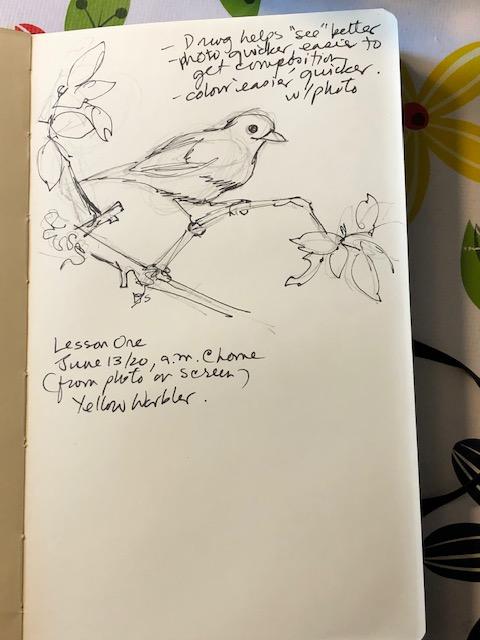
 Getting started with drawing from a picture is a great way to get started. Understanding how to draw the different textures was very difficult. Nature journaling will allow me to observer greater detail that I have not noticed previously.
Getting started with drawing from a picture is a great way to get started. Understanding how to draw the different textures was very difficult. Nature journaling will allow me to observer greater detail that I have not noticed previously. 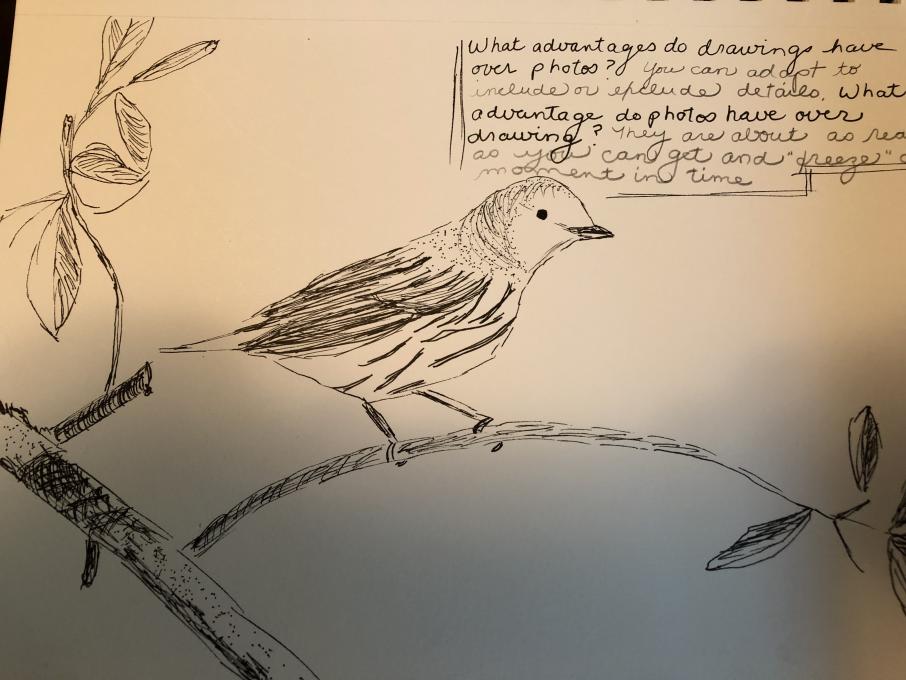
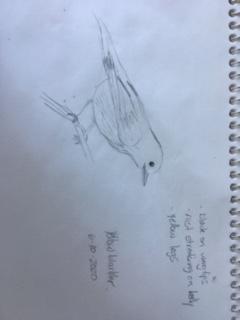 The beak was challenging for me. I think I really notice the proportions when I have to draw something. I think that is the advantage of drawing for a nature journal, you are forced to look at all of the details
The beak was challenging for me. I think I really notice the proportions when I have to draw something. I think that is the advantage of drawing for a nature journal, you are forced to look at all of the details 
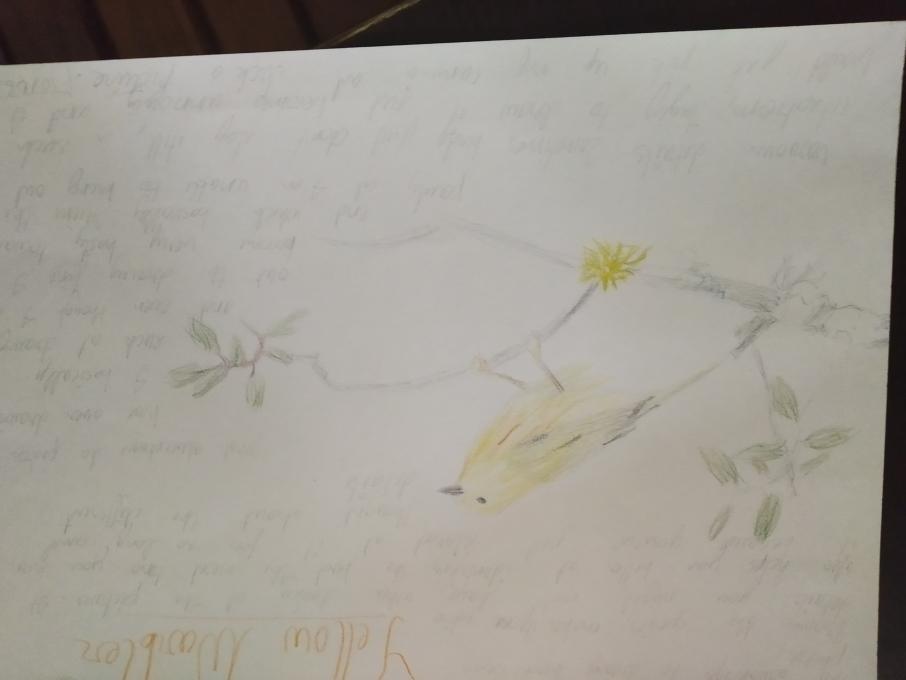

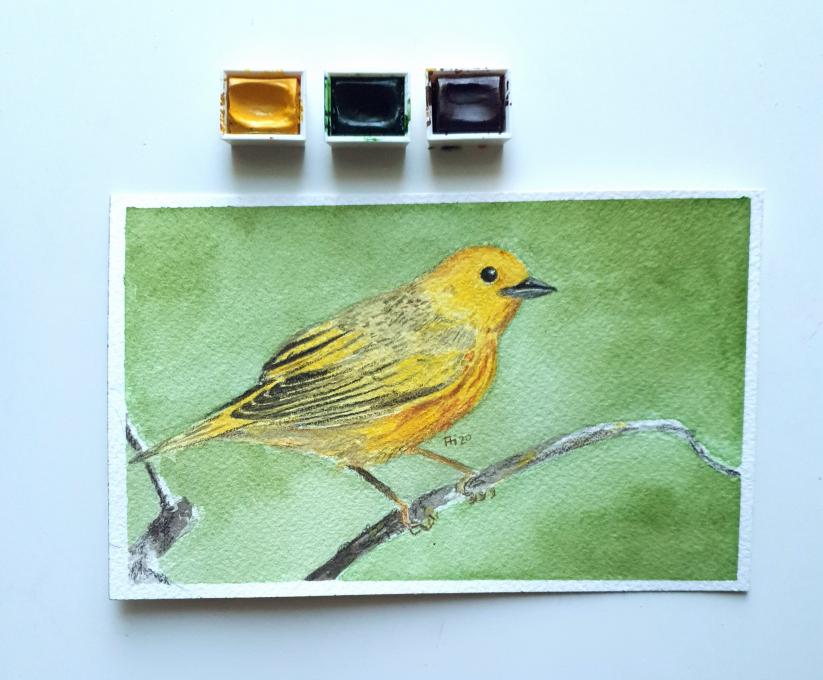

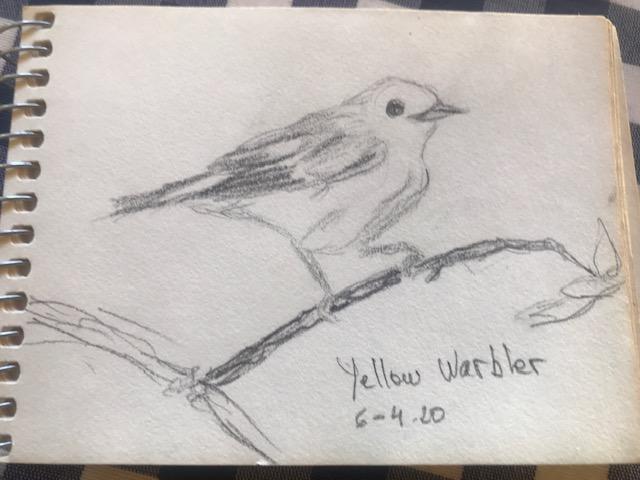 I was able to take my time so I guess it felt easier than nature journalism. The texture was less challenging than what I thought but the form was challenging. I would´t have noticed the different levels of the wings or the subtle orange stripes in the body. Yes, I think it must be quite different To catch details and poses in live movement,
I was able to take my time so I guess it felt easier than nature journalism. The texture was less challenging than what I thought but the form was challenging. I would´t have noticed the different levels of the wings or the subtle orange stripes in the body. Yes, I think it must be quite different To catch details and poses in live movement, 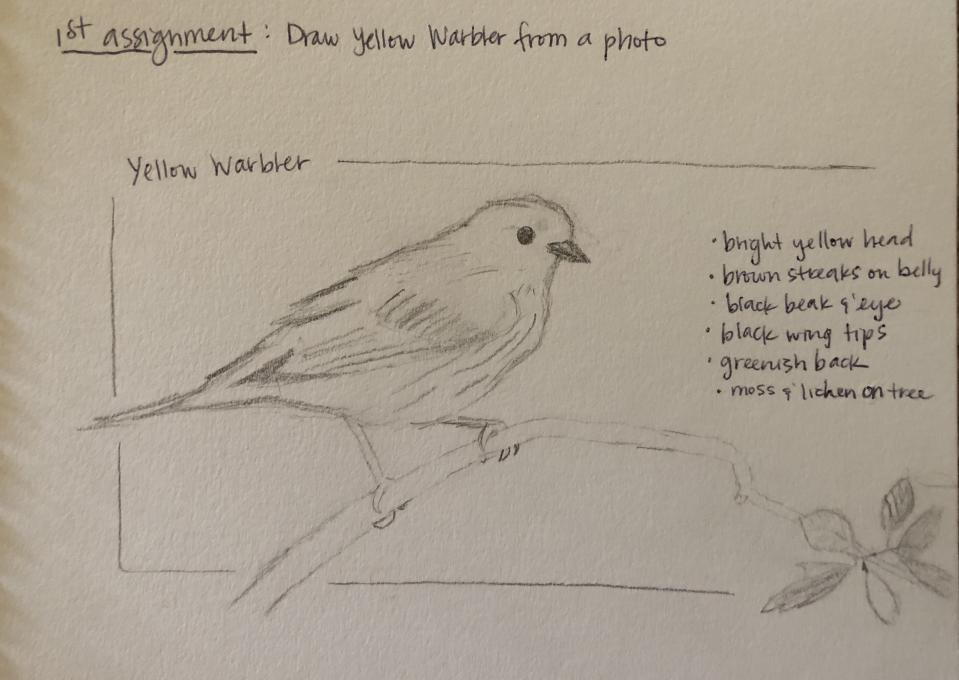 It is much easier to draw from a photo. It gives me time to notice lots of details and work to make my drawing more accurate. The more details I add to my drawing, the more I learn about the subject and the better I remember the experience.
It is much easier to draw from a photo. It gives me time to notice lots of details and work to make my drawing more accurate. The more details I add to my drawing, the more I learn about the subject and the better I remember the experience. 
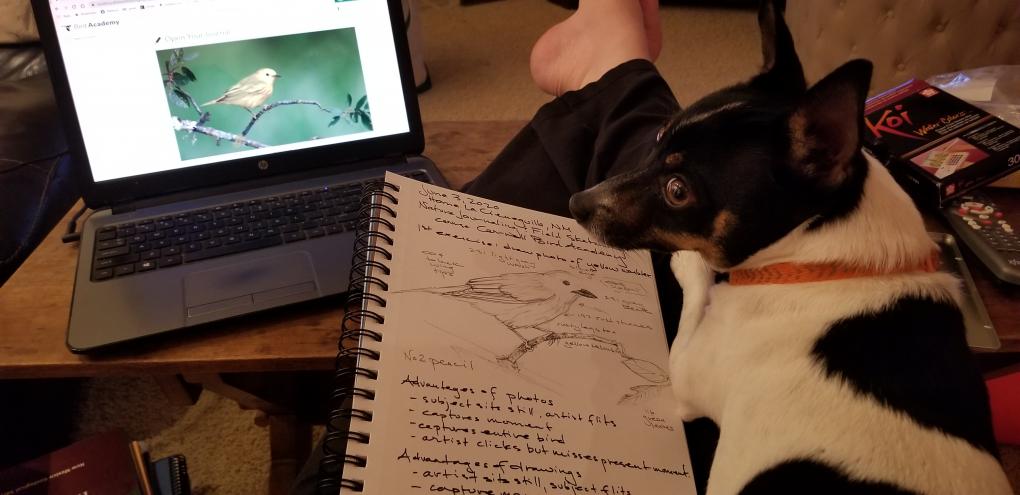 While drawing I realized that I do not know bird anatomy very well so I was drawing what I saw without understanding what it was or how it works, this can be a + or - to the overall picture. Drawing from a photo is easy tho I am very rusty. I did use my eraser a few times. I liked the talons wrapping around the branch and want to draw these again in close-up. Pixel, my rat terrier, is glad that I'm done drawing so my lap is available.
While drawing I realized that I do not know bird anatomy very well so I was drawing what I saw without understanding what it was or how it works, this can be a + or - to the overall picture. Drawing from a photo is easy tho I am very rusty. I did use my eraser a few times. I liked the talons wrapping around the branch and want to draw these again in close-up. Pixel, my rat terrier, is glad that I'm done drawing so my lap is available. 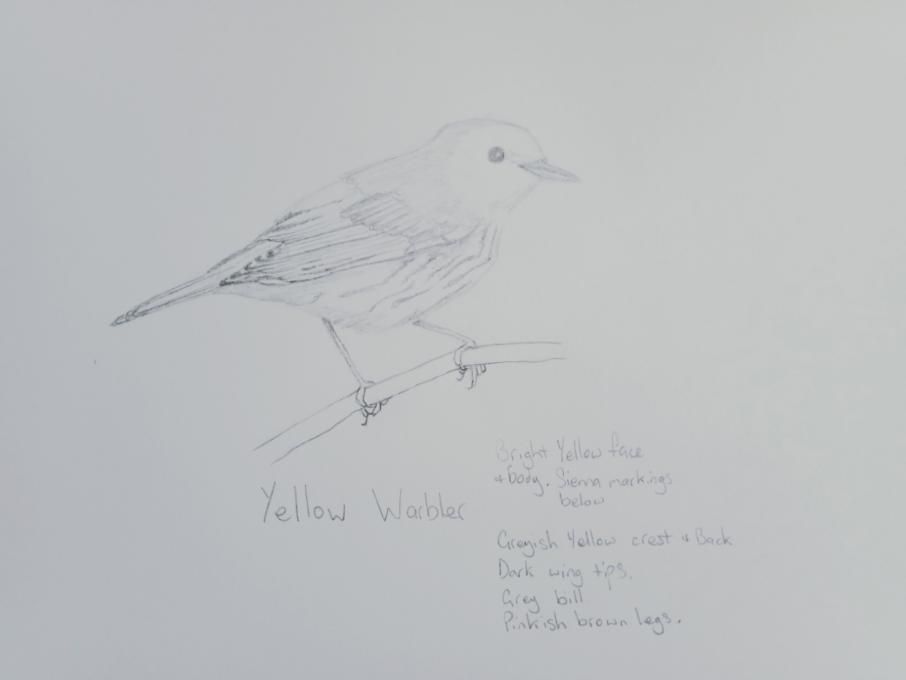
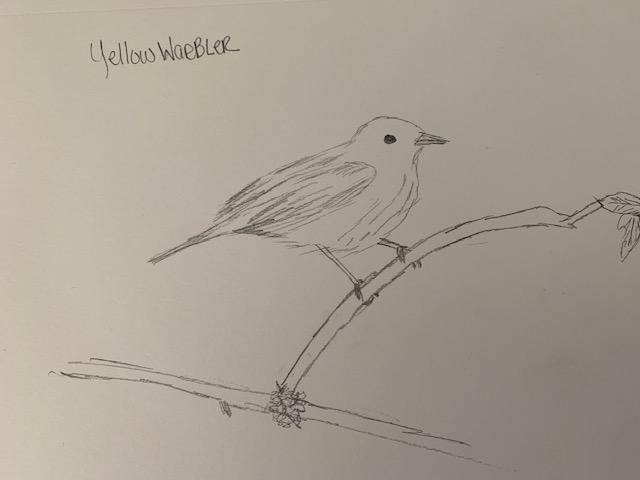
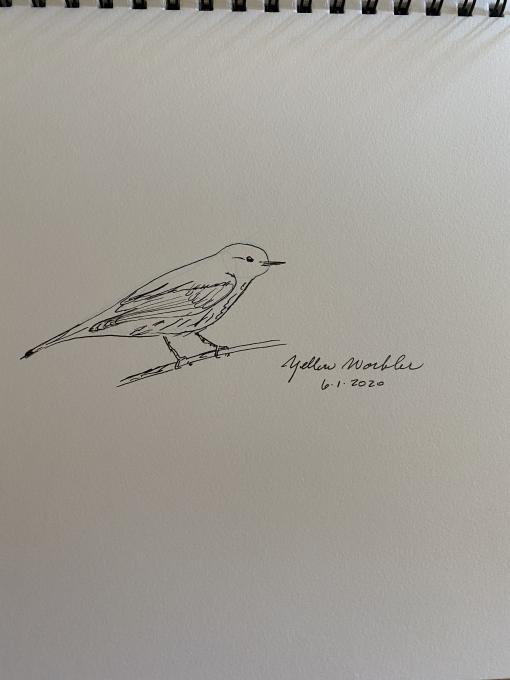
 Here is my Warbler drawing. Sorry that it's not very clear, my computer camera isn't very good.
Here is my Warbler drawing. Sorry that it's not very clear, my computer camera isn't very good.  Drawing from a photograph is fine - it allows me to take my time drawing, however, it feels like “flat”; a 2D image is being copied. It is good if i cant stay outside for long due to the weather conditions. The joy of observing is not there though.
I noticed the texture of the Podotheca as well as the form of the beak. Noticing the details is very important in nature journaling; it us part of sensing the bird being watched. It is of importance to point that observing bird’s behaviours for a while is enriching our visual memory. So that when we sketch it from a photograph -even if the photo is a bit blurred due to its fast movement- we will still be able to draw it accurately.
After uploading the image, i noticed that I forgot to add the name & information of the bird ^_^;
Drawing from a photograph is fine - it allows me to take my time drawing, however, it feels like “flat”; a 2D image is being copied. It is good if i cant stay outside for long due to the weather conditions. The joy of observing is not there though.
I noticed the texture of the Podotheca as well as the form of the beak. Noticing the details is very important in nature journaling; it us part of sensing the bird being watched. It is of importance to point that observing bird’s behaviours for a while is enriching our visual memory. So that when we sketch it from a photograph -even if the photo is a bit blurred due to its fast movement- we will still be able to draw it accurately.
After uploading the image, i noticed that I forgot to add the name & information of the bird ^_^; 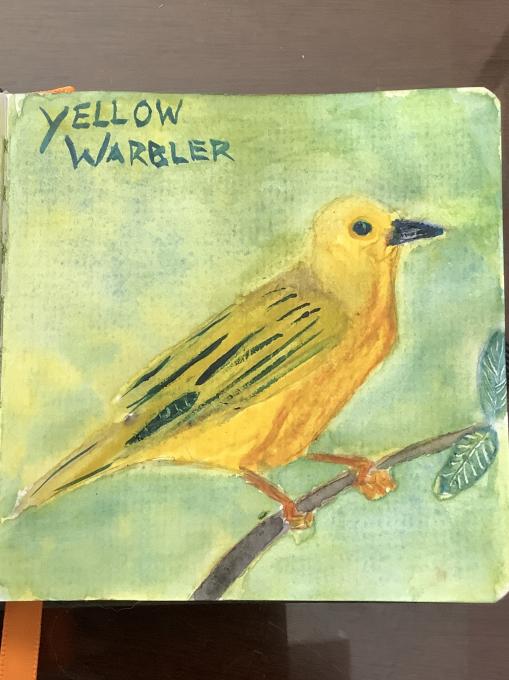
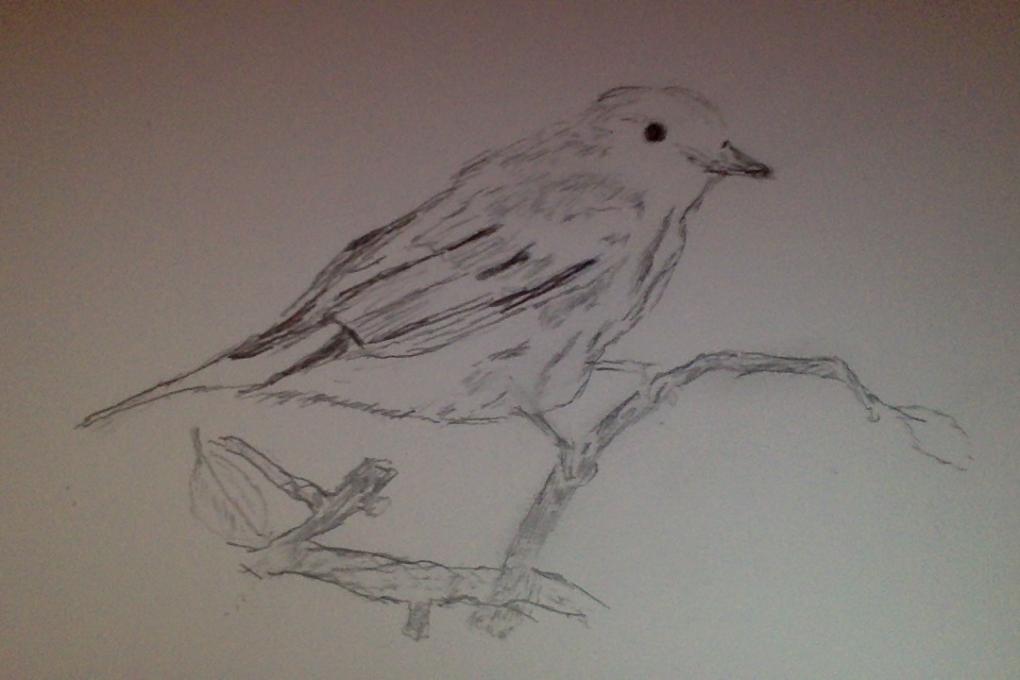
![IMG_1062[11213]](https://academy.allaboutbirds.org/wp-content/uploads/hm_bbpui/706137/vfmr4kz3j0ixbi67d7orz464taywrjdr.jpg) Since I have been paying attention to the warblers and the parts of songbirds recently I feel it came a little easier to figure out the details of the feathers.
2. There are several things I might not have noticed from the photo if I didn't draw it:
Since I have been paying attention to the warblers and the parts of songbirds recently I feel it came a little easier to figure out the details of the feathers.
2. There are several things I might not have noticed from the photo if I didn't draw it:
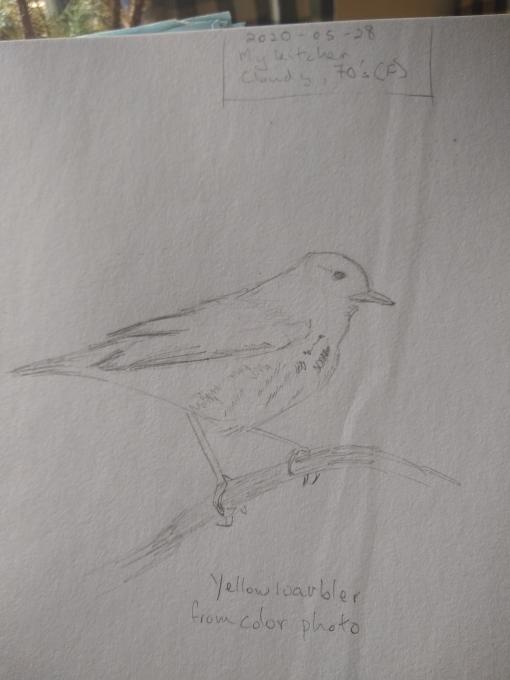
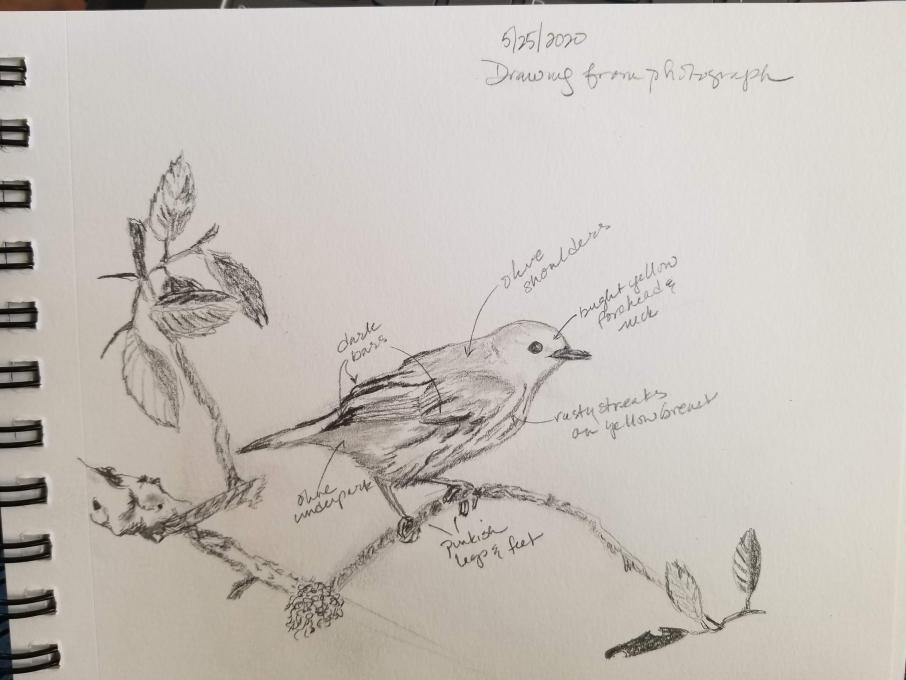 Not bad for my first attempt at drawing in several years. Even after several rounds with the eraser I still didn't get the shape quite right, but it's definitely recognizable as a bird, and maybe even as a yellow warbler. Drawing from the photo gave me an opportunity to see all the features and identify which bits were shadow and which were actual markings, and I don't think my observations would have been nearly as detailed if I weren't drawing. Obviously birds in the wild generally aren't going to sit still for this kind of observation, but I think practicing this kind of drawing from photos might train me to see those kinds of details more quickly when I'm looking at a moving target.
Not bad for my first attempt at drawing in several years. Even after several rounds with the eraser I still didn't get the shape quite right, but it's definitely recognizable as a bird, and maybe even as a yellow warbler. Drawing from the photo gave me an opportunity to see all the features and identify which bits were shadow and which were actual markings, and I don't think my observations would have been nearly as detailed if I weren't drawing. Obviously birds in the wild generally aren't going to sit still for this kind of observation, but I think practicing this kind of drawing from photos might train me to see those kinds of details more quickly when I'm looking at a moving target.